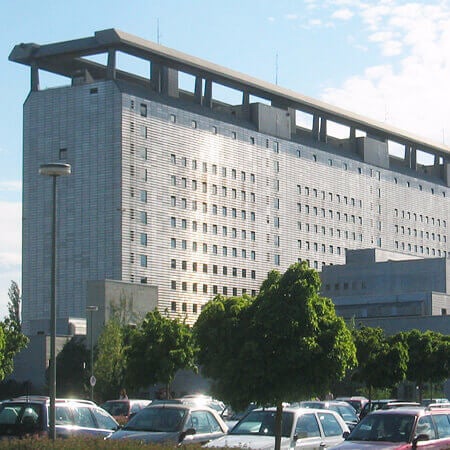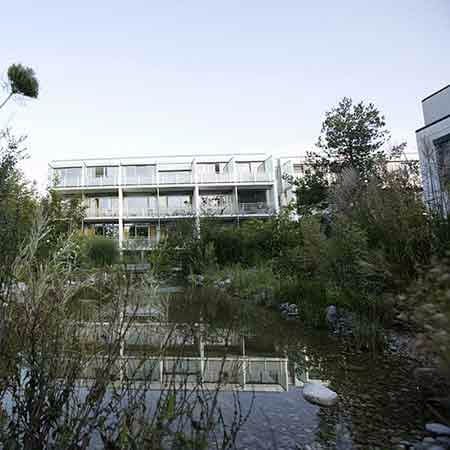Testicular dropsy (hydrocele) is the accumulation of liquids between the membranes of the organ. The disease can be congenital or acquired. Any form of the condition is an indication for treatment, which can be provided with an open surgery, endovideo-assisted surgical operations, or a minimally invasive procedure (sclerotherapy). You can undergo your treatment abroad to get reliable results, avoid complications, and maintain your fertility. You are welcome to visit the Booking Health website to find out the cost of treatment, compare prices at different hospitals, and choose the best medical care program.
Content
- Diagnostics
- Who may need treatment?
- Hydrocele treatment principles
- What operations can be performed for hydrocele treatment?
- Sclerotherapy
- Why to undergo your treatment abroad?
Diagnostics
Most patients go to a doctor with complaints about:
- swelling in the testicles;
- enlarged testicles;
- pain in the scrotum that occurs when walking, having sexual intercourse, or urinating.
Sometimes a man has no symptoms other than a cosmetic defect.
Diagnostics begins with a clinical examination and palpation of the scrotum. A doctor draws attention to the pear-shaped swelling. Palpation of the testicles is painless.
The main methods of instrumental diagnostics are diaphanoscopy and an ultrasound scan. In rare cases, when there is doubt about the diagnosis, an MRI scan may be performed. Those men who are interested in maintaining and improving their reproductive function also have a spermogram.
Who may need treatment?
The fact that a hydrocele or dropsy of the testicles has been detected is an indication for treatment, as it doesn't matter if a person is experiencing any symptoms. Over time, a hydrocele may increase in size. The condition causes complications, for example, inflammation with suppuration (pyocele) and bleeding with the formation of a hematoma. A hydrocele is a risk factor for testicular torsion, ruptured testicles, or testicular cancer.
In adult men, the disease impairs sperm quality and may lead to secretory infertility. Moreover, it is not always possible to restore reproductive function after hydrocele treatment surgery, so it is worthwhile to timely perform the operation before the testicular tissues die due to poor blood supply.
Hydrocele treatment principles
There are no conservative treatments that could eliminate a hydrocele. You can get rid of this pathological condition only with the help of surgery or a minimally invasive procedure.
There are three main approaches to the treatment of dropsy of the testicle:
Open surgery is the most common treatment option. This type of operation provides good results with a probability close to 100% and has a minimal risk of recurrence. The operation may, however, cause complications and require hospitalization. And what is more, swelling in the scrotum after the operation persists for several weeks or even several months.
Minimally invasive surgery is the method that is becoming more widespread in developed countries. States with a low level of medicine still rarely use this treatment option. Minimally invasive operations are no less effective, but they are safer and less traumatic for the patient. They, however, require special equipment and skills, so such operations can only be performed at specialized centers. If you opt to have your treatment abroad, the specialists from the Booking Health company will select a hospital where doctors offer minimally invasive surgical treatment.
Sclerotherapy is the injection of a substance between the testicle membranes that causes them to fuse together. As a result, there is no cavity, and there is nowhere else for liquids to accumulate. This procedure does not require any skin incisions, as the sclerosant is injected into the scrotum with a needle.
What operations can be performed for hydrocele treatment?
Dozens of operations have been developed for the treatment of dropsy of the testicle. They are performed through an incision in the scrotum. The essence of any surgical procedure is suturing, excision, or coagulation of the testicle membranes. Most operations are comparable in their efficiency, but they differ in their trauma and risk of recurrence and complications. The most common types of interventions are as follows:
Bergmann's operation is considered the best option for a large, old, and multi-chambered hydrocele with an excess of testicle membranes. During the operation, part of the membranes is removed, and another part is sutured.
Winkelmann's operation involves the dissection of testicle membranes, followed by their eversion and suturing them behind the testicle.
Lord's operation is being increasingly used for hydrocele treatment in developed countries, as this operation is the most sparing. It does not require the removal of the testicle into the wound. This means that the surgical procedure does not interfere with testicular blood circulation and lymph flow, therefore eliminating the risk of any damage to blood vessels. Doctors dissect the testicle membranes, release the liquids, and apply eight corrugated sutures to the patient's own tunica vaginalis.
Testicle membrane endovideo-assisted excision is a modern, minimally invasive intervention that is safe and non-traumatic. This surgical procedure can also reduce the length of a hospital stay and rehabilitation. Doctors perform manipulations with thin and long instruments under the guidance of a tiny video camera. The instruments are inserted into the scrotum through incisions 3-4 mm long. This operation can be performed even on a large hydrocele.
Sclerotherapy
Sclerotherapy is an alternative treatment option for hydrocele. This is a minimally invasive procedure, during which doctors inject a sclerosant into the testicle. It initiates an inflammatory reaction between the testicle membranes, where liquids accumulate. As a result, the layers of the patient's own tunica vaginalis stick together.
The procedure is performed under local anesthesia. Urologists abroad perform a spermatic cord block to completely eliminate the sensitivity of the scrotum, since the injection of a sclerosant causes pain.
A doctor inserts a needle between the testicle membranes and evacuates the liquids. Instead, a sclerosing agent is injected in a volume equal to 10-50% of the volume of the liquids. Most often, it is ethyl alcohol, while other sclerosants, for example, phenol, polidocanol, or ethanolamine, are not very commonly used. The sclerosing agent is left between the testicle membranes for 20-30 minutes, and then aspirated. Urologists abroad perform the procedure under the guidance of ultrasound diagnostics to reduce the risk of complications.
Below are listed some of the advantages of sclerotherapy compared to surgery:
- sclerotherapy is less traumatic than operations;
- sclerotherapy does not require any hospital stay;
- patients can quickly return to their normal lives;
- sclerotherapy can be performed in elderly patients with contraindications to surgery.
The disadvantage is the lower efficiency compared to the operation. After the first procedure, the final result can only be achieved in 60% of cases. After several (from 2 to 4 procedures), the efficiency reaches 95%, which is still less than that of operations, since hydrocele treatment surgery is successful in almost 100% of cases.
Why to undergo your treatment abroad?
You can undergo your hydrocele diagnostics and treatment abroad to cure the disease with sparing and least traumatic techniques, and with a low risk of complications. Modern operations and procedures allow doctors to treat your hydrocele forever.
These are some of the reasons for you to undergo your treatment abroad. These are as follows:
- Accurate diagnostics with which doctors can distinguish a hydrocele from cancer, cysts, varicoceles, and other pathologies, as well as determine the best treatment method.
- Safe hydrocele treatment is available at any age, from children in the first two years of life to older men with concomitant somatic diseases.
- Doctors use the most modern modifications of surgical operations to reduce the risk of complications.
- Surgeons perform endovideo-assisted operations through short incisions on the scrotum.
- Patients with a high risk of complications can undergo a minimally invasive procedure, namely, sclerotherapy, instead of surgery. It is done under the guidance of ultrasound diagnostics to reduce the risk of complications.
- Adequate pain relief eliminates pain and discomfort during operations and minimally invasive procedures.
- Preservation of reproductive function.
- Treatment in developed countries provides reliable results, as hydrocele will not recur.
You can find out the cost of treatment and choose a medical care program at the best price on the Booking Health website. Our specialists will help you choose a hospital and organize your trip. When you make an appointment for your treatment abroad through the Booking Health service, the cost of treatment for you will be lower than when you contact the hospital directly. The price will be reduced due to the absence of additional taxes for foreign patients. You will receive insurance against unexpected medical expenses, so the initial cost of treatment is guaranteed not to increase after the start of the program.
Authors:
The article was edited by medical experts, board-certified doctors Dr. Nadezhda Ivanisova and Dr. Sergey Pashchenko. For the treatment of the conditions referred to in the article, you must consult a doctor; the information in the article is not intended for self-medication!
Sources:
MedicineNet
The Lancet
Sience Direct
















